#and increasing cognitive function. For example
Text












"Raise the world's vibration by spreading kindness and positivity through your actions and words." D.M.
"Art activates the brain and beautifies the soul, leading to a more fulfilling and meaningful life."
ABI RESOURCES
Art has been shown to have a number of positive effects on the brain, including reducing stress, improving mood, and increasing cognitive function. For example, viewing art has been found to lower levels of the stress hormone cortisol, while also increasing activity in the areas of the brain associated with pleasure and reward. Additionally, engaging in art-making activities, such as painting or drawing, has been found to improve fine motor skills and increase creativity. Some studies also suggest that art therapy, which combines art-making with psychotherapy, can be effective in treating mental health conditions such as depression and anxiety.
ABI Resources works with multiple organizations, including DSS, DMHAS, WWP, CCC, CCCI, SWCAA, WCAAA, Allied, Yale, UConn, Gaylord, HFSC, and more to provide the best care for individuals.
ABI Resources’ commitment to creating an inclusive and supportive community for clients is well known. They offer a variety of team-building activities, social events, and volunteer opportunities to help clients stay engaged and connected with others. This not only helps clients recover from their injuries but also helps them build friendships, create social connections, and gain a sense of belonging.
#HOT#BALLOON#AIR#ART#LOVE#FAMILY#BRAIN
#Art activates the brain and beautifies the soul#leading to a more fulfilling and meaningful life.#“Raise the world's vibration by spreading kindness and positivity through your actions and words.” D.M.#ABI RESOURCES#Art has been shown to have a number of positive effects on the brain#including reducing stress#improving mood#and increasing cognitive function. For example#viewing art has been found to lower levels of the stress hormone cortisol#while also increasing activity in the areas of the brain associated with pleasure and reward. Additionally#engaging in art-making activities#such as painting or drawing#has been found to improve fine motor skills and increase creativity. Some studies also suggest that art therapy#which combines art-making with psychotherapy#can be effective in treating mental health conditions such as depression and anxiety.#ABI Resources works with multiple organizations#including DSS#DMHAS#WWP#CCC#CCCI#SWCAA#WCAAA#Allied#Yale#UConn#Gaylord#HFSC#and more to provide the best care for individuals.#ABI Resources’ commitment to creating an inclusive and supportive community for clients is well known. They offer a variety of team-buildin
1 note
·
View note
Text
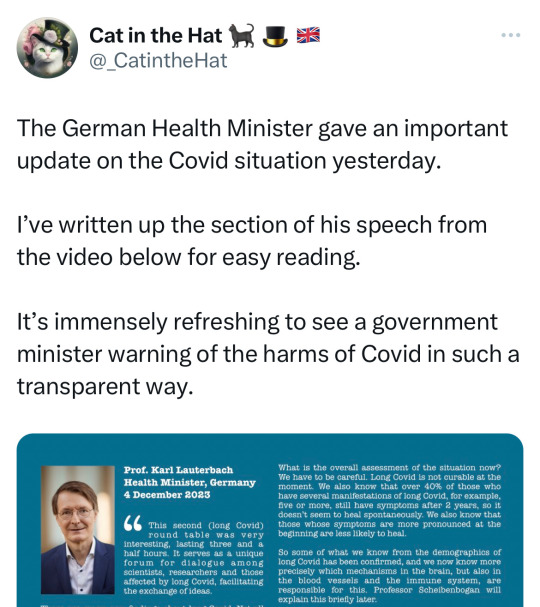
Cat in the Hat:
"The German Health Minister gave an important update on the Covid situation yesterday.
I’ve written up the section of his speech from the video below for easy reading.
It’s immensely refreshing to see a government minister warning of the harms of Covid in such a transparent way."
https://x.com/_catinthehat/status/1732092683508678954

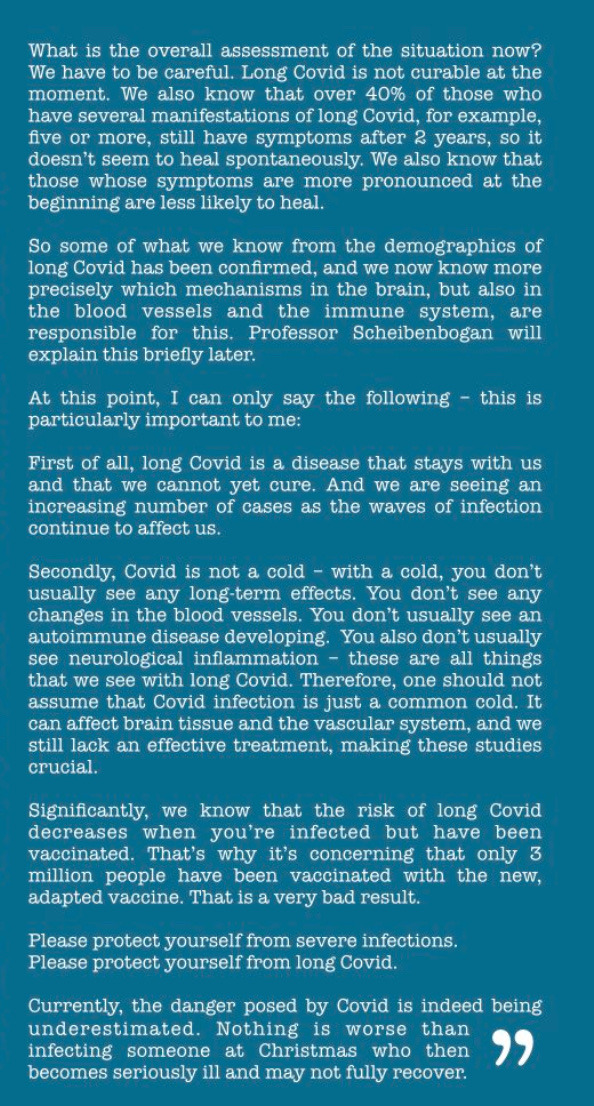
Prof. Karl Lauterbach
Health Minister, Germany
4 December 2023
"This second (long Covid) round table was very interesting, lasting three and a half hours. It serves as a unique forum for dialogue among scientists, researchers and those affected by long Covid, facilitating the exchange of ideas.
There are many new findings about long Covid. Not all of them are good news. One piece of not-so-good news concerns the fact that long Covid is actually still a problem for those who are newly infected. One estimate that has been put forward is that the risk of contracting long Covid now, even after vaccination, is around 3%. Now you may say, "that's not such a big risk" , but there are tens of thousands of people who are repeatedly affected in a short period of time. And so, the long Covid problem has not yet been solved.
We have also established that there really are many subgroups of long Covid and that we do not yet have a cure. And it was clearly pointed out that we are also dealing with problems here that will challenge society as a whole, because vascular diseases often occur after long Covid. Throughout Europe, we are currently seeing an increased incidence of cardiovascular disease in the middle-age group - from 25 to 50. This is associated with the consequences of Covid infections.
We also very often find cognitive impairment in older people. And one participant pointed out that it may well be like the Spanish flu, where 20 years after the Spanish flu there was a significant increase in Parkinson's disease and probably also dementia.
This is something we must pay attention to, as the past infection afiects how the immune system in the brain functions, as well as the brain's blood vessels, potentially increasing the long-term risk of these major neurodegenerative diseases. This is why we need to conduct very intensive research. This research has played a major role.
What is the overall assessment of the situation now?
We have to be careful. Long Covid is not curable at the moment. We also know that over 40% of those who have several manifestations of long Covid, for example, five or more, still have symptoms after 2 years, so it doesn't seem to heal spontaneously. We also know that those whose symptoms are more pronounced at the beginning are less likely to heal.
So some of what we know from the demographics of long Covid has been confirmed, and we now know more precisely which mechanisms in the brain, but also in the blood vessels and the immune system, are responsible for this. Professor Scheibenbogan will explain this briefly later.
At this point, I can only say the following - this is particularly important to me:
First of all, long Covid is a disease that stays with us and that we cannot yet cure. And we are seeing an increasing number of cases as the waves of infection continue to affect us.
Secondly, Covid is not a cold - with a cold, you don't usually see any long-term effects. You don't see any changes in the blood vessels. You don't usually see an autoimmune disease developing. You also don't usually see neurological inflammation - these are all things that we see with long Covid. Therefore, one should not assume that Covid infection is just a common cold. It can affect brain tissue and the vascular system, and we still lack an effective treatment, making these studies crucial.
Significantly, we know that the risk of long Covid decreases when you're infected but have been vaccinated. That's why it's concerning that only 3 million people have been vaccinated with the new, adapted vaccine. That is a very bad result.
Please protect yourself from severe infections.
Please protect yourself from long Covid.
Currently, the danger posed by Covid is indeed being underestimated. Nothing is worse than infecting someone at Christmas who then becomes seriously ill and may not fully recover."
Alt text is included in all images of this post.
#covid#not a cold#please wear a mask#pandemic#pandemic not over#long covid#Karl Lauterbach#Germany#German health minister
10K notes
·
View notes
Text
A while back I argued tik tok was a hypnosis and brainwashing app because its function hits all the major components of hypnotizing someone: distracting audio/visual, music, repetition, eroticism etc. A lot of people think of being hypnotized only as falling into a deep sleeplike trance but there's also low level hypnotism where you may not even notice a shift in consciousness. The idea is that all of these things in conjunction relax your mind, puts your criticial thinking on pause and increases your susceptibility to accepting a desired message.
Well now I learned that tik tok "sludge" videos are a thing where they play multiple videos all at once, which also demonstrates the hypnosis rule of 7. 7 points of stimulus overloads the brain and reduces focus, because nobody can keep focus on 7 things at once your brain just kind of unfocuses making it more likely that a subliminal suggestion can take root. So if you have 2 or 4 videos playing all at once you have 3 different audio outputs, 5 different visuals it forces your brain to tune some things out and not process it with your higher cognitive functions. Hypnosis is all about making you think that something you think was your own thought when really it was given to you without your knowing. This doesn't mean these videos have to contain some hidden message...the videos themselves are just a way to soften you up mentally for videos and messages that follow...which also get curated to you.
What are the messages people are getting. I've heard for example people who were noticing they were getting fed trans topics on tiktok and were at first like...wtf this isn't for me...who then became trans. I don't use the app so I don't know what kind of propaganda people get served a lot but I'm sure its not good. Makes me wonder how much of a factor it was in peoples behaviour during covid. People were absolutely not in their right minds.
And once again even the name tik tok evokes the concept of a metronome which is a common visual and auditory tool used in hypnosis. Your phones are literally brainwashing you. Do not let your kids use tik tok.
542 notes
·
View notes
Text
Hi everyone,
I found a helpful article discussing autistic burnout. I’ll leave some excerpts from this article below:
“Autistic burnout’ is the intense physical, mental or emotional exhaustion, often accompanied by a loss of skills, that some adults with autism experience. Many autistic people say it results mainly from the cumulative effect of having to navigate a world that is designed for neurotypical people.
Burnout may especially affect autistic adults who have strong cognitive and language abilities and are working or going to school with neurotypical people.”
“Like many aspects of autism, burnout varies greatly from person to person. Some autistic people experience it as an overwhelming sense of physical exhaustion. They may have more difficulty managing their emotions than usual and be prone to outbursts of sadness or anger. Burnout may manifest as intense anxiety or contribute to depression or suicidal behavior. It may involve an increase in autism traits such as repetitive behaviors, increased sensitivity to sensory input or difficulty with change.
Burnout can sometimes result in a loss of skills: An autistic woman who usually has strong verbal abilities may, for example, suddenly find herself unable to talk.”
“Burnout is often a consequence of camouflaging, or masking, a strategy in which autistic people mimic neurotypical behavior by using scripts for small talk, forcing themselves to make eye contact or suppressing repetitive behaviors. These strategies can help autistic people in their jobs and relationships but require immense effort.
It can also result from sensory overstimulation, such as a noisy bus commute; executive function demands such as having to juggle too many tasks at once; or stress associated with change.”
The full article will be down below for anyone who would like to read through it. I hope many of you found this helpful and informative.
Autism Burnout
#autism#actually autistic#autism burnout#what is autism burnout#signs/symptoms of autism burnout#autism burnout explained#if you’re neurodivergent feel free to reblog
249 notes
·
View notes
Text
So the thing I didn't mention in that poll I published yesterday is that the motor initiation piece that is, at the time of this writing, absolutely sweeping the poll as the Worst Thing people struggle with?
It's the specific thing I'm trying to pull together a grant for, perhaps unsurprisingly. But it's also the only one that actually isn't classically conceptualized as executive function. (I know, I know, that feels stupid to me, too.)
See, formally speaking, we describe executive function in terms of higher-order cognitive processes that allow us to complete complex tasks. There is a lot of work on, for example, "set shifting" (which is a particular paradigm for studying the ability to transition between different frames of mind, essentially; it's measuring cognitive flexibility) and on action inhibition / impulse control. (One of my colleagues works on set shifting, in fact, and I might actually take a look at that later.) We also have a lot of work on how individuals make decisions and prioritize conflicting needs.
But the transition between motivation and motion is a lot harder to study, and it doesn't fit so neatly into this top down paradigm, either. Most of the people who study this kind of movement initiation are people who aren't really focused on executive function per se at all. They're mostly people who work on Parkinson's, in fact.
The problem is that the best way to untangle how these systems work is to break specific things and see what impact that has on the overall function, and that means working with animal models. You know what we can't study as easily with animal models? Wanting to move and not being able to initiate self-paced motion—that is, we can't get inside an animal's head to understand what it wants to do in the absence of a moving body to indicate that thing. This is part of why many of our best studied kinds of executive dysfunction involve not doing a thing, rather than doing it: that way you can look at error rates and study a measurable change in behavior.
There are things we can do, though. For example, you can disentangle motivation versus pleasure in a rat that enjoys things but has no motivation to make them happen by asking questions like: I know that rats like water with sugar in it. If I set up a device that squirts a trickle of sugar water into the mouth of the rat, does it close its mouth? What facial expressions does it make? If I put bitrex in the water instead of sugar, does the reaction change? (Yes, emphatically.)
The thing is, motivation is regulated by dopamine... and so is movement. There's good reason to think that neurodevelopmental disorders like ADHD and autism are mediated by weird dopamine signaling patterns, and we certainly know that there is a direct relationship between abnormally high dopamine signaling and schizophrenia symptoms... and that abnormally low dopamine will give you Parkinsonian tremors.
Most stimulant meds for ADHD work by upregulating dopamine signaling, too. All of them are associated with increased locomotor activity, among other things. We know that dopaminergic signaling precedes actions in the body, too: you get firing before the actual motion happens.
Somewhere there is a threshold of motion initiation that is getting fuckily disconnected. I have some thoughts about where it is, but I definitely need to run some experiments to check my hypotheses against evidence.
#Executive function#Neurodivergence#autism#I have got to make myself some canonical tasks here#Tags not tasks#Animal research#Day job#Neuroscience
67 notes
·
View notes
Text
NEUROPLACISITY IN DEPTH.


(The content isn't mine but all complied into one big post, links are connected to the sources)
How do I re-wire my subconscious?
You re-wire your subconscious mind using NEUROPLASTICITY.
Neuroplasticity, also known as brain plasticity or neural plasticity, refers to the brain's ability to reorganize itself by forming new neural connections throughout life. It involves the strengthening or weakening of existing neural pathways and the development of new synapses.
This means you can re-wire your subconscious by building NEW PATHWAYS that become STRONGER than the old ones
I'd like you to start with understanding the importance of BDNF - Brain-derived neurotrophic Factor (BDNF) is a vital protein for neuroplasticity, acting as a linchpin in the adaptive processes of the brain. It supports facilitating synaptic plasticity through mechanisms like long-term potentiation (LTP) and fostering the formation of new synapses. You can increase your body's BDNF by:
Engage in regular exercise, particularly aerobic activities, to significantly increase BDNF levels and promote neuroplasticity.
Maintain a balanced diet rich in omega-3 fatty acids from sources like fatty fish and flaxseeds to support elevated BDNF production.
Prioritize adequate and quality sleep, as insufficient sleep has been linked to decreased BDNF levels.
Implement stress management techniques, such as mindfulness meditation and relaxation exercises, to positively influence BDNF secretion.
Breathwork and meditation are great options.
Understand the importance of regulating your nervous system - You must be able to regulate your nervous system to build neuroplasticity. This is because neuroplasticity may be hindered when the body is in a heightened state of stress or arousal (sympathetic dominance), characterized by increased heart rate and elevated cortisol levels. Breathwork and meditation are an incredible way to do this.
Psych central
Take new routes: Every new experience has the potential to enhance your brain’s ability to change. Travelling, for example, can help. Our brains are forced to stop auto-piloting in an unfamiliar environment like a new city. Research from 2013 shows that novelty and challenges can enhance cognitive function. So, technically, you don’t have to leave your town to promote brain plasticity. Consider finding alternative routes to your daily commute. Try that new coffee shop or restaurant around the corner. Go around your desk in the opposite direction that you typically do.
Move: A 2018 literature reviewTrusted Source showed that physical exercise can promote neuroplasticity in general. Activity is beneficial for many different regions of the brain and affects various aspects of cognitive function, including memory and learning. This might be helpful for people facing major or mild cognitive decline, including Alzheimer’s disease. In sum, exercising may help you slow the cellular ageing process and enhance your overall brain health.
Practice meditation: Studies show that long-term meditation practiceTrusted Source can change the function of the brain. Specifically, mindfulness practice can enhance focus and attention and prevent cognitive declineTrusted Source.
Learn a new skill: The relationship between learning and neuroplasticity is twofold. Learning new things enhances brain plasticity, and because of the brain’s ability to adapt to change, you’re able to learn. In this sense, every time you learn something, you benefit from neuroplasticity and promote it.
Research backs this up.
A 2021 study, for example, suggests that learning a new skill, such as Braille language, can promote neuroplasticity and enhance its benefits.
Other examples include learning to:
- use your non-dominant hand
- speak a new language
- play a new instrument
- paint or draw
- code computers
- do puzzles
55 notes
·
View notes
Text
Anyways, so I've been seeing this gross misinterpretation of my post on unnecessary hysterectomy and I'd like to explain, even though the OP has me blocked (unsurprising).
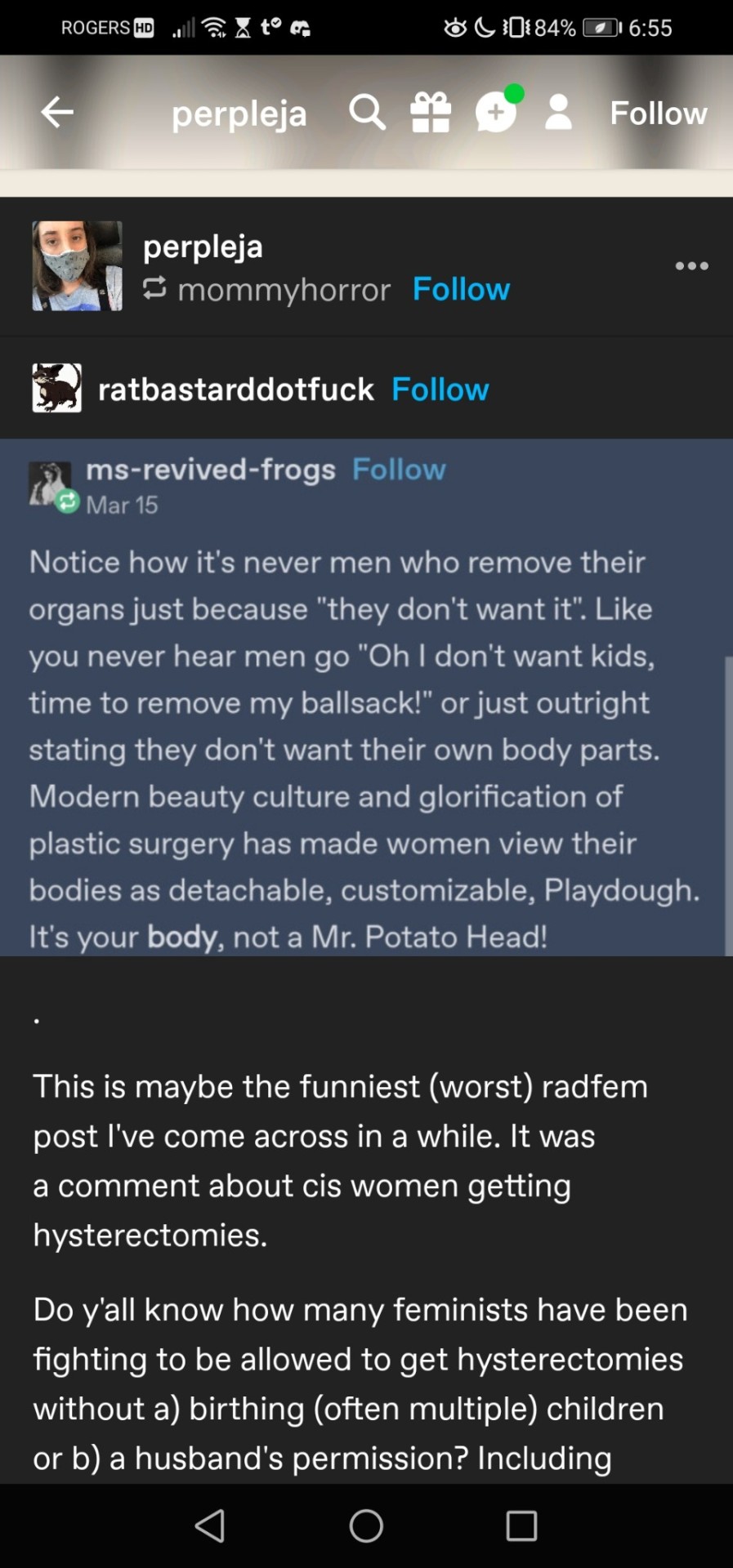





Gotta love seeing my post resurfacing and being taken wildly ou of context! Anyways @ratbastarddotfuck and @vergess, the meaning of my post was not that hysterectomy should be banned. I know that hysterectomy is oftentimes medically necessary for the health of a woman. And no, I do not believe it should be restricted only until after a woman might have had a child. I am not right-wing and do not believe this is woman's "role".
However, my post was in reference to this new phenomenon of young women trying to get hysterectomies simply because they never intend to have children or because they don't like having periods. Meanwhile there better, less invasive, and less damaging surgeries out there! One example can be tubal ligation. As back-not-broken said on the post, the uterus plays a key role outside of reproduction. New research is showing that the uterus has a role in your cognitive function (removing it is linked to higher risk of Alzheimer's), and plays a structural role as well (removing it is linked to risk of prolapse). In my post, I was attributing this desire for unnecessary hysterectomy to beauty culture and plastic surgery culture. Because yes, these two involve the division of the female body into a collective of parts, rather than one whole human organism. Women are already en masse cutting themselves up, and making the bulk of almost every plastic surgery (nose jobs, liposuction, BBLs). And while men out there do get these surgeries sometimes, they are getting them at a far less severe degree than women. So as feminists, we must inquire as to why women specifically are doing this and not men as much. And the answer of course points to self esteem issues and societal voyeurism into what a woman's body is or should be. It's not a coincidence that all these women are getting surgeries to look like the media's ideal woman. And it's not a coincidence that the media treats women like a collective of parts ("Increase your bust with X product!" "Shave your body hair with X product!" "10 ways to make your butt look bigger!").
I think the funniest part about this extremely liberal interpretation is that the idiot @vergess decided to list... wisdom teeth removal, tonsillectomy, and kidney donation, as if these all were done with the same intention as women wanting to cut out healthy organs because they don't intend on reproducing. Neither of the three above can lead to prolapse or Alzheimer's, and neither of them are male-exclusive either. Almost all of @vergess examples were gender-neutral! Which proves exactly my point that it is mainly women who are encouraged to cut themselves from inside out unnecessarily. Once again, I'm not speaking of medically necessary hysterectomy.
It's feminists' duty to analyse the societal behaviours of man and woman. Why should this be off limits, when it is so invasive and dangerous?
137 notes
·
View notes
Note
Hey, I noticed that you tag all your posts with long covid, and I was wondering if you've read the study where they found the cause of long covid brain fog. file:///C:/Users/12406/Downloads/s41593-024-01576-9.pdf
I also made a translation that puts the abstract into easier terms, and I'm working on the rest of the study.
Vascular disruption has been implicated as a symptom of COVID and might predispose the neurological symptoms of long covid, yet it is unclear how blood–brain barrier (BBB) function is afected in these conditions. Here we show that BBB disruption is evident during acute infection and in patients with long COVID with cognitive impairment, commonly referred to as brain fog. Using advanced brain imaging, we show BBB disruption in patients with long COVID-associated brain fog. RNA analysis of peripheral blood mononuclear cells* revealed dysregulation of the coagulation system and dampened adaptive immune response in individuals with brain fog. Accordingly, blood cells showed increased adhesion to human brain endothelial cells** in test tubes. Together, our data suggest that sustained systemic infammation and persistent localized BBB dysfunction is a key feature of long COVID-associated brain fog.
*mononuclear blood cells refer to blood cells that have one nucleus. They make up most of your immune system.
**The cells that make up the walls of your blood vessels. Specifically designed to be slippery because when blood cells adhere to them it causes clotting - this is the dysregulation of the coagulation system they were talking about.
Let me know what you think! Or if you have questions
I find it very interesting that many people with long covid land up getting many autoimmune disorders. I have a few autoimmune disorders and have many, if not most, of the symptoms that people with long covid have. For example, I can not read what you wrote, just parts of it. I have cognitive issues, sometimes severe.
9 notes
·
View notes
Text
Friday, March 31, 2023
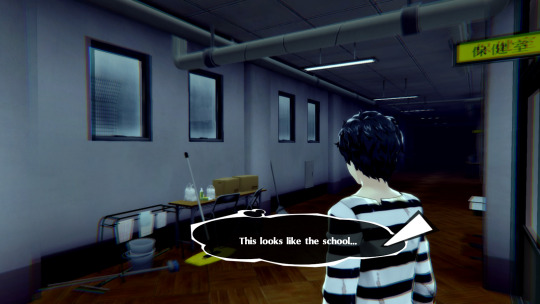
In Persona 5 Royal, just before New Year's, Joker has a strange dream in Shujin Academy as he transitions into Maruki's Cognitive Reality.
But how does this scene work, on a technical level? Strictly speaking, like this. Gross.

Let's go step by step and cover what exactly is going on here.
In P5R, every time slot of every day is controlled by a "Scheduler" BF File. BF, otherwise known as Binary Flowscript, is a low-level bytecode scripting format created by ATLUS back in 2004 that most Persona games use.
The game loads a Scheduler function based on the current timeslot, and each function is named after the timeslot it occurs on, so we can determine this takes place on Year 1, December 31st in the Late Evening.

It's important this takes place on the Late Evening instead of next morning, as the shading and coloring data of Shujin Academy at night is much more moody and appropriate. Additionally, at night, all NPCs in Shujin are despawned.
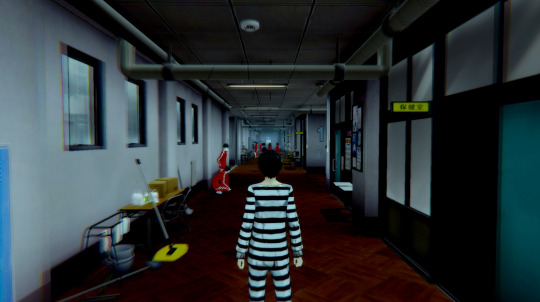

After turning off the Date UI, the game loads Event ID 485_310, a sort of precursor where Joker wakes up confused in Maruki's Office.


Afterwards, the script sets COUNT values 18 and 22. COUNT values are special integers stored in the game's save data but often come with special properties. 18 and 22 set Joker's current field model ( .GMD ) and animation set ( .GAP ).
18 parses the integer as several arguments, in this case loading c0001_117_00.GMD, while 22 loads the requested field animations in BF0001_212.GAP. c0001_117_00.GMD is his Velvet Room Prisoner attire with GAP 212 being a slow, shambling walk.


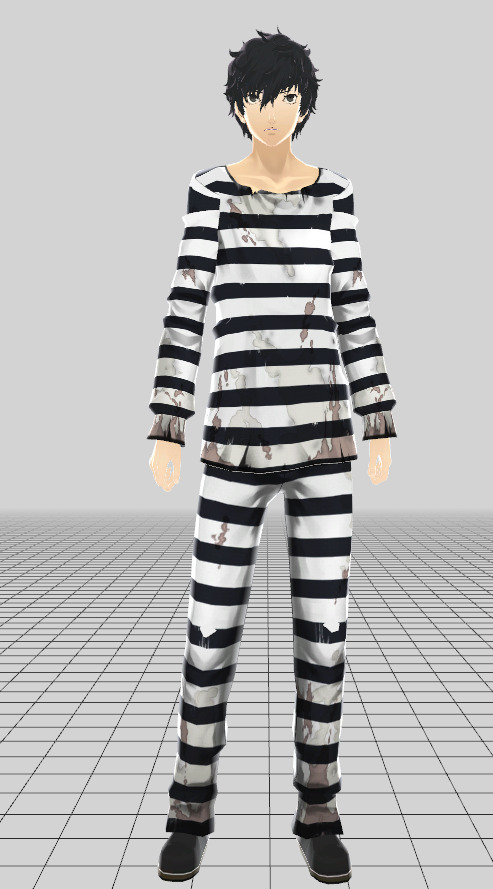
After setting many flags in the game's memory linked to specific features like disabling the main Triangle menu, the game sets COUNT 0X10 ( A.K.A 16 ) and calls Keyfree Event 651_103.
While a regular Event in the game is a regular cutscene, a Keyfree Event is a sequence where you're allowed to walk around. Take for example, any chase scenes or special sequences.
Keyfree events work by essentially overriding every file associated with a specific field, whether it be trigger data, npc placement, script functions, etc, and replacing it with special curated Keyfree files.


Interestingly, this Keyfree chose specifically not to include a modified INIT script, so the scene where joker glances around and assumes he needs to go home is actually performed by the normal Shujin Academy INIT script every time you load into the field.
This is why COUNT 16 is set before loading the Keyfree, the Shujin Academy INIT checks this value to determine which of several Keyfree story sequences it's in to pass onto MAIN_65110100_MidnightSchool_Ready()

After setting the Place Name from Shujin Academy to ??? - ??? and redundantly setting Joker's model and animations, EVT_CA_START() applies a wavy Chromatic Aberration to the screen, making it appear hazy.

The rest of the script is dedicated to making joker walk into the hallway and setting up the Blue Butterfly you chase, which is actually an NPC!

Set along the hallways are various invisible trigger boxes that activate the function EVT_CA_BUTTON_ANIME(), a special function created mostly just for this scene that temporarily paints the screen blood red while increasing the strength of the hazy Chromatic Aberration.

This is how the Keyfree event mostly plays out! Various invisible triggers exclusive to this Keyfree are hit that tell the game to move the butterfly farther away while playing specific voicelines and at the very end the last trigger plays a normal Event showing Joker rejecting the new reality before proceeding on with Year 2, January 1st!
That's all for now, see you soon!

58 notes
·
View notes
Note
What do you think the 40's Characters quirks would be if they were in My Hero Academia (excluding Midoriya, of course)?
Oh, I have been WAITING for this one!
(Remember, all these quirks and hero names are subject to change!)
MCS (WE): Hero Names and Quirks
Note: Some hero names are not related to their quirks
Emitter:
Italy: Secoli (Centuries), The Italian Hero
Quirk: Weapons Manufacturer
He can create weapons from his body, but only weapons that were made in Italy, ranging from the past time period to current. He needs to be full aware of what the weapon is and how it works
Drawback: If he makes too many, he will deplete himself of energy, so carbohydrates are a must!
(I just like the idea of Italy being a powerhouse despite his pacifist personality)
Heine Wittgenstein: Omniscient, The Tutoring Hero
Quirk: Knowledge Extraction
He can touch a person and extract the knowledge he needs into a form of writing and/or pictures. He needs to know exactly what he needs to extract otherwise the information will end up jumbled.
Drawback: He gets headaches if he takes too much information.
Levi Ackerman: Kapitän, The Soldier Hero
Quirk: Dual Swords
He can produce a single, long blade from the inside wrist of each hand, which are each strong enough to cut through anything! The length of the blades can reach up to half of his body length but the strength of his blades depends on his iron intake, meaning the more iron in his diet, the stronger his blades.
Drawback: He is unable to retract his blade once they are released and his wrists will start to get irritated, (red, itchy), if they produce blade too times consecutively.
Credit to: juniperarts at Twitter (@juniperjadelove)
Satoru Fujinuma: Rewind, The Time Hero
Quirk: Time Projection
By making skin contact with someone, he can show someone's memories from the palms of his hands. He can only show up to at max five minutes of memory and it's one touch per memory. The further it goes back, the more concentration he needs. He also needs a date for more accuracy.
Drawback: If he uses his quirk too much or tries to show the memory even longer, he will become disoriented.
Satoru Gojo: Kami, The Sorcerer Hero
Quirk: Expand
He is able to expand the area he's in, while not affecting those outside his area. Unlike domain expansion, it doesn't take all of his energy just by creating it. And the more sugar he eats, the bigger the area he can create.
Drawback: If he keeps expanding too much and or for too long, it can cause his sight to lose depth perception.
Spike Spiegel: Dragon Fist, The Bounty Hunter Hero
Quirk: Bullseye
He can shoot or throw anything with perfect accuracy. But he must be able to see or visualize the target. His range can reach up to 600 feet in any direction (up/down/etc.)
Drawback: Using his quirk consecutively too many times in a row can cause temporary blindness.
Saitama: One Punch Man, The Punching Hero
Quirk: Strength Boost
He can give anyone additional strength by making skin contact. Almost like an energy boost, this allows the person to be stronger than they usually are, but it only allows them to push through any pain or tiredness. For example: He can give a boost to someone who is completely exhausted, but it doesn't mean they're not exhausted anymore, they just have the strength to keep going, even if it hurts.
Drawbacks: He can only do a limit of 15 people, considering how strong he already is, but will become extremely fatigued if he pushes past his limit.
L Lawliet: Lawless, The Investigating Hero
Quirk: Glucose
The more sugar he intakes, the higher his IQ increases.
Drawback: While his brain can burn the sugar faster which allows to consume more sugar than the average human, using his quirk too much can cause a slight impairment of his cognitive function, but putting all of it together means that the draw happens VERY, VERY rarely.
Yuuri Katsuki: Eros, The Ice Hero
Quirk: Brittle Frost
From his hands and breath, he can freeze anything they come into contact with. Unlike Todoroki who can create ice blast, he can only freeze the area he is touching and focus on spreading it to where it becomes brittle.
Drawback: Using it for too long can cause him to get frostbite himself.
Naegi Makoto: Nozomu (Hope), The Inspiring Hero
Quirk: Inspiration
By talking to anyone, he can make anyone feel inspired or hopeful, which can work great with completing a goal. But if he talks too long to someone using his quirk, they'll start to go for unrealistic goals.
Drawback: Using it too much can cause his throat to get sore much faster than a normal talker, so he keeps cough drops on hand.
Haruka Nanase: Mizu (Water), the Freestyle Hero
Quirk: Friction
He can change the degrees of friction on his whole body or parts of his body from less resistance to most resistance . For example, he can choose to have no friction, which can make him faster or be dealt with less physical harm when in a fight, or can have the most friction which can allow to climb walls or be kept from being blown away.
Drawback: When it is used too long, his own friction will change randomly and rapidly from high to low, making it difficult to move from say after a long fight. Water, or most specifically, a sensory deprivation tank works great as a recharging station for him.
Korra: Hikari (Light), The Descend Hero
Quirk: Spirit Sight
Unlike that to her Avatar power, she can see spirits who have not moved on to the other side. She can allow other people to see them but only five at a time.
Drawback: Major headaches if she uses too much or goes past her limits.
(Korra is already OP, plus I want to see her get in more in touch with her spiritual side.)
Langa Hasegawa: Summit, The Winter Hero
Quirk: Gravity Dial
He can manipulate his own gravity to the point where he has a lot, too little, or basically none.
Drawback: Like Uraraka, he will get sick if he uses too much of it.
Mako Mankanshoku: Meta, The Fourth Wall Hero
Quirk: Cartoon Logic
She basically runs under the rules of “Cartoon Logic”, well more so then she already does. Her quirk can also affect those around her/anyone she choses. While cartoon logic leaves herself and others unharmed, she also chose to have people be unaffected, meaning that anything that can’t hurt a cartoon character can most certainly hurt the person in question. And when her quirk is activated, she can see beyond the fourth wall and has a hammer space, but she needs to put items into said hammer space for it itself cannot create objects on their own.
Drawback: She will become increasingly tired and disoriented if she pushes herself too far. Eating lots of food will hold off the drawbacks and replenish her.
(What have I done?!)
Chika Fujiwara: Love Detective, The Emotional Hero
Quirk: Inner Heart
She is able to see how someone really feels about another person, but she is unable to see how people perceive her.
Drawback: Seeing too many hearts at the same time can cause her to lose her filter.
Kusuo Saiki: Versatile, The Psychic Hero
Quirk: Meld
By touching an inanimate object, he can take control of it. But unlike telekinesis, he can actually command the object to do what he wants. He controls up to ten objects at a time.
Drawback: Controlling something for too long can cause him to lose mental focus.
Mafuyu Sato: Treble Chief, The Song Hero
Quirk: Soundtrack
He can sing/play a song and it will affect a situation depending on what type of song it is, like playing a heroic song will give the heroes the win or playing a sad song will cause misfortune. As long as he knows the whole song and can play it, even if it’s on one instrument, it’s fair game. He can just play the instrumental, but if he can sing it or add lyrics to it will increase the odds in his favor. But when the song starts to end, the quirk will lose its hold and he will need the same amount of time of how long the song was to recharge before he can use his quirk again. But listening to songs while at rest will speed up the process, plus it will increase the power of his quirk.
Drawback: His fingers and hands will get stiff and or lose his voice if he goes on for too long.
Ryota Suzui: Jack of Trades, The Wagering Hero
Quirk: Gamble
He can make a bet or gamble with someone or multiple people and either side wins the bet/gamble the other must follow through the wager. If neither side does, then they will become physically sick until they complete the wager. However, the other party he is betting with must agree to the bet. And he must take an equal trade. Which is why, for the lamest term, this quirk is a gamble to use on the battlefield. But as long as he sets rules and guidelines for the bet, there may be a greater chance for him to win. Plus the more gambles he wins, the greater his odds are in future gambles.
Drawback: Aside from losing a bet, he’ll become more paranoid about outcomes of any situation.
Edward Elric: Fullmetal, the Alchemist Hero
Quirk: Biological Transfiguration
He can change anything organic he touches to inorganic materials. But while he does need to understand the composition of the material, there is no law of equivalent exchange. But the transformations can only last for at most 5 minutes. Plus eating things with protein and calcium will help, (which means yes he will have to drink milk.)
Drawback: His limbs will start to grow stiff and heavy if he transfigure too many things.
Haruhi Fujioka: Endear, The Natural Hero
Quirk: Charm
Thanks to her already natural grace, she can charm-speak to anyone she comes across and can last up to 5 minutes per person before she has to wait another 5 minutes to reset.
Drawback: If she uses charm on too many people, the end result would be the equivalent to after running a marathon.
Senku Ishigami: Dr. Stone, The Science Hero
Quirk: Medusa
Just like the name, he can turn people into stone just back making eye contact with them. On its own the petrification lasts up to 15 minutes and he can do up to 10 people at most.
Drawback: He himself starts turning into stone. It can be fixed by using Nital, but his own limbs will still feel heavy.
(Credit to j001005420 on Deviantart)
Shoyo Hinata: Shinobi (Ninja), The Decoy Hero
Quirk: Duplicate
Using any kind of light, he can duplicate himself. But the more he makes, the less stable they become. And the more light he is in, the more energy he will have, like a plant.
Drawback: He with become disoriented if he duplicates too much.
(I know many people either go for speed based or flight based quirks, but I wanted to utilize his ability to fool others/having his opponents underestimate him.)
Soma Yukihira: Kaizen, The Chef Hero
Quirk: Chemical Reaction
He is able to produce different factors in his hands to create a reaction (chemicals, pressure, heat, etc), The five basic types being combination, decomposition, single-replacement, double-replacement, and combustion. He’ll need to know the chemicals and factors that cause the reaction in order for it to work. He technically cannot be harmed by these reactions, but caution is still advised. Eating food will help restore his energy.
Drawback: His hands will start to lose feeling if he produces too many reactions.
(Does it feel like I'm stretching with this one?)
Tanjiro Kamado: Steel Edge, The Demon Slaying Hero
Quirk: Whetstone
He can take about anything and turn it so sharp, turning it into a weapon itself.
Drawback: Hands will start to cramp if used too much.
Iruma Suzuki: Ten'nō (Emperor), The Leading Hero
Quirk: Animal Summon
He can summon any animal he chooses to help him, but the sizes of the animal, the type, and where they're from must be taken into account of difficulty. For example: Say Iruma is in Japan. For example, beetles are easy to summon but if there's only a specific type found in America, then that would make it harder to summon. But take a tiger, which would be hard to summon, but if there are a specific type are found in Japan, then it would be a bit more easier compared to the beetles.
Drawback: Fatigue from summoning, depending on how many and or what type. Keeping snacks on him will help restore his energy.
Hanako-kun: Poltergeist, The Haunting Hero
Quirk: Sensory Deprivation
He can deprive someone of one or all five of their senses but he has to skin to skin five finger contact in order for it to work.
Drawback: Uses too much of it and he too will start to lose his own five senses.
Killua Zoldyck: Giga Watts, The Electric Hero
Quirk: Energy Transfer
He can take energy from one thing, and transfer to another. It can transfer from object to object, object to human, human to object, or human to human. But it is safer to do the transfer from the same type since one different type to another can result in too much intake of energy to too little intake of energy.
Drawback: It may take a while, but his own energy will be depleted if he uses too much.
Emma: Himawari (Sunflower), The Cheerful Hero
Quirk: Healing Petals
She can grow Himawaris and feed the petals to others to heal them. The greater the injury, the more petals she would need, but she cannot regrow limbs.
Drawback: Grow too many flowers and she will start to feel under the weather.
Transformation:
U-1146: Neuturotekutā (Neutrophil), The Leukocyte Hero
Quirk: Cell Alteration
As a cell himself, he can transform into other cells and gain the skill sets that come with said cell. But he needs a deep understanding of the cell itself and how it functions before he can change into them.
Drawback: It’s easy for him to change into, but harder to get out of.
Kae Serinuma: Aficionadress (aficionado), The Otaku Hero
Quirk: Environmental Archetypes
When thrown into a situation, she can change herself into a persona to fit the situation in both looks and personality.
Drawback: If she stays as a persona for too long, she will slowly forget who she is and lose her memories. Best way to counter this is by having someone nearby keeping her grounded.
Legoshi: Ipomoea Alba (Moonflower), The Canidae Hero
Quirk: Wallflower
He can turn into the surrounding plants in the vicinity. Whether it’s just a potted plant or a whole field, he just needs to know what kind of flower it is in order for it to work.
Drawback: When he changes back, he might be covered in pollen, petals, or leaves depending on the plant. The longer he stays as one, the more there will be stuck on him
Rin Okumura: Blue Exorcist, The Anti-Diabolist Hero
Quirk: Mythical
He can shapeshift into mythical creatures, but ONLY mythical creatures. And any powers associated with said creature he will have.
Drawback: He cannot stay as a mythical creature too long otherwise he will start to lose himself.
Tetsuya Kuroko: Phantom, The Unseen Hero
Quirk: Shadow Travel
By turning into a literal shadow, he can both cling to a moving one and travel through stationary shadows and take others along with him. He needs to know and has to been already to the location he wants to travel to. The smaller the shadow, the harder it is to travel through.
Drawback: If he uses too many times, his lack of presence will increase sufficiently, to the point of which he becomes ghost-like, (Unable to touch things, nobody can hear him, etc).
Tohru Honda: Constella, The Zodiac Hero
Quirk: Chinese Zodiac
She is able to transform into any animal of the Chinese zodiac, including the cat. Unlike Hatori and Kureno, she can turn into said animals, and in their adult forms. But the bigger the animal is compared to her, the harder it is for her it is to transform. The transformations are all or nothing, but she can even communicate to other animals in her forms.
Drawback: Transforming too much can make her emotionless.
Zuko: Blue Spirit, The Hearth Hero
Quirk: Life Flame
He can turn himself into fire and burn at different temperatures at will. While his weaknesses are that of regular flames, he has more resistance to them since it cannot actually kill him.
Drawback: The longer and hotter he uses his life flame will result in him overheating and having a raging fever as an end result. Combined with the fact that he is a firebender, his temperature would be abnormally high and he could burn or melt anything that his body or parts came into contact with in his fainted state.
Shigeo Kageyama: Mob, The Esper Hero
Quirk: Ghost
He can turn into different types of ghosts. The more well known a type of ghost is to him, the easier it is to shift. Any power or physical appearance of said ghost will be present.
Drawback: He will feel disoriented and lethargic if he stays as a ghost for too long.
Ciel Phantomhive: Cerberus, The Nobleman Hero
Quirk: Canine
He can change to partly having features or completely into a dog. It can either be a wild or a domestic dog, but he needs to know which type of dog he's doing when changing only one or two attributes, ex. smell and sight, since each dog is better at one category then another.
Drawback: He will become a bit more aggressive and territorial if he keeps his changes for too long.
Mutation:
Kobayashi: Mazādoragon (Mother Dragon), The Dragon Hero
Quirk: Dragon
While mainly humanoid, she has the physical attributes of a dragon such as wings, tail, eyes, claws and even horns. Her abilities are flight, strength, and fire breathing.
Drawback: Her main drawback comes from her fire breathing, because if she uses it too much, she’ll slowly lose breaths to produce them and will gain a fever.
Nagisa Shiota: Madowasu (Beguile), The Snake Hero
Quirk: Naga
His lower body is that of a snake. He has scales around his neck and face, slitted eyes, retractable fangs, and a forked tongue. He feels the vibrations in the ground, smells the air with his tongue, and can constrict his enemies. If he truly feels threatened, he can produce a paralyzing venom from his fangs.
Drawback: Aside from fatigue from fighting for too long, he is cold blooded. So he cannot be in a cold environment for too long otherwise he will slip into hibernation.
#main character syndrome (with exceptions)#the 40#the_ravenclaw_werewolf#ask & answer#hulkchloron99#MCS (WE): Hero Names and Quirks#cowboy bebop#spike spiegel#avatar the last airbender#zuko#the legend of korra#korra#ouran high school host club#haruhi fujioka#death note#l lawliet#black butler#ciel phamtonhive#hetalia#hetalia north italy#fullmetal alchemist#edward elric#blue exorcist#rin okumura#hunter x hunter#killua zoldyck#kuroko's basketball#tetsuya kuroko#attack on titan#levi ackerman
20 notes
·
View notes
Photo
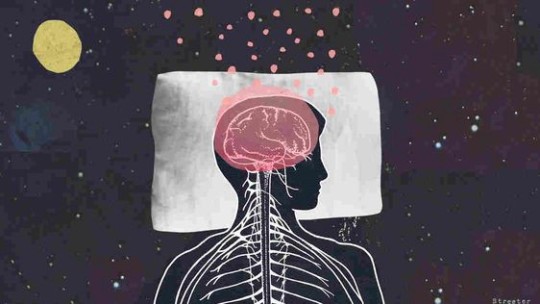
Why do I cheat on my partner so easily in a dream?
Have you ever noticed in a dream you can cheat on your partner without having even a shadow of a doubt it’s the right decision? Well, it is definitely not your unfaithful nature; it is all about our brain’s workings, especially some parts of it which we are going to examine here.
The Frontal Cortex
The Frontal Cortex is located at the very front of the brain and is responsible for not only long-term planning, decision making, knowledge analysis and regulation of emotions, but also for social behavior control. This means that the frontal cortex prevents different types of inappropriate behavior, such as aggression, desires to steal, compulsivity and sexually assaultive behavior. As a result, damage to this lobe might cause, for example, a complete lack of interest in sex or, contrastively, more active sexual behavior. So why does this matter in terms of sleeping?
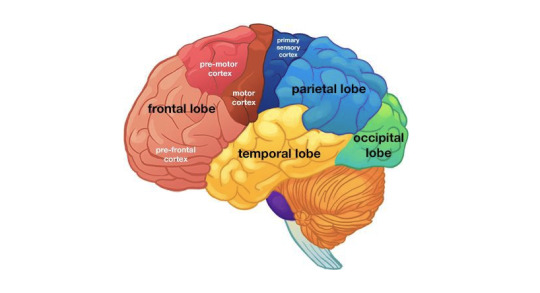
The Sleep Cycle
Our sleep cycle consists of two main stages: non-rapid eye movement (NREM) sleep and rapid eye movement (REM) sleep. During the latter stage, our body experiences temporal muscle paralysis and, more interestingly, — dreams (if you don’t have any brain damage that could lead to dream loss). The question about the purpose of dreams is still in dispute, but there is a clear answer at why they are ridiculously illogical sometimes:
during REM sleep, the frontal lobe is “turned-off” affecting our social behavior in a dream
There is also a range of research supporting this statement. For example, in one experiment, scientists activated the frontal lobe of the participants during REM sleep and noticed that such stimulation “induces self-reflective awareness in dreams”. In other words, you act more appropriately and logically as your frontal cortex is stimulated while sleeping:
Recent findings link fronto-temporal gamma electroencephalographic (EEG) activity to conscious awareness in dreams, but a causal relationship has not yet been established. We found that current stimulation in the lower gamma band during REM sleep influences ongoing brain activity and induces self-reflective awareness in dreams. Other stimulation frequencies were not effective, suggesting that higher order consciousness is indeed related to synchronous oscillations around 25 and 40 Hz.
Noticeable effects on dreams
As you can imagine, this temporal “shutdown” of the frontal cortex has a huge impact on our social behavior in a dream: from aggressive conversations to having sex with your partner’s best friend. Don’t feel guilty; it’s just your brain! What about moments when you act consciously in a dream and do things with full awareness of your actions?
Lucid Sleep
Lucid sleep is a sleep during which you are aware of dreaming while dreaming (apologies for the tautology). Recent studies suggest that this phenomenon occurs due to “increased brain activity over frontal regions during REM sleep”. However, other researchers analyze it through the states of consciousness theory. These two points of view are not interchangeable but complementary.
Now let’s look more closely at different states of consciousness:
- Primary states of consciousness — states in which dreams “are concerned with the immediate present, with only uncontrolled access to the past or the anticipated future”
- Secondary states of consciousness — states in which people are able to manipulate with “higher order cognitive functions such as self-reflective awareness, abstract thinking, volition and metacognition”. In the case of sleeping, this mode is “turned-on” after awaking
So, when both states coexist together, a person experiences a lucid dream. It is like being simultaneously asleep and awake! What is more, humans are most likely the only species able to experience such a thing.
Source: Anastasiia (Medium). Image: Katherine Streeter for NPR.
250 notes
·
View notes
Text
Stardew Valley mod rec compilation
this is a regular question asked on the discord so I wanted to put together my own constant pack to link.
These are NOT all mods I use. These are the mods I’m **completely confident **in recommending together, that definitely work well, combine well and won’t create any cognitive dissonance.
(Note that I’m not listing any prerequisites. Whichever mod you’re installing, you obviously need to install its prerequisites too)
(Most of these are on Nexus, but not all. MARGO is on GitHub, for example. Search on Nexus first, then duckduckgo or google it if it’s not there)
Utility if-you’re-modding: (mods that maybe won’t improve your game per se and you don’t want to install Just Them if you’re picking and choosing, but if you’re already using other mods, you want to look at these)
Advanced Save Backup (obvious function is obvious, don’t let mod fuckups permanently ruin your save)
Generic Mod Config Menu (absolutely mandatory if you’re installing like… >1 other mod)
CJB Cheats Menu + CJB Item Spawner (the more mods you have the more likely you’ll need this to recover after glitches. There are vanilla bugs you might want this to help you with too)
Jump Over (or noclip, in case you get stuck somewhere)
Mod Update Menu (fully optional, but might be nice)
Quality of Life (mods that I’m completely confident work well together and will improve your game withough particularly changing it. You do want to meddle in config for many of these though. Increase complexity at your own pace)
Action Sitting
After Midnight Speed Buff
Easy Coal
Balanced Quarry
Better Artisan Good Icons
Better Beehouses
Better Chests
Better Ranching (turn off “prevent failed harvesting” in config, add Fix Animal Tool Animations for that functionality instead)
Bigger Backpack
Collapse on Farm Fix
Destroyable Bushes
Gift Rejection
Grass Growth
Horse Overhaul - Immersive Scarecrows
Immersive Sprinklers
Lucky Rabbit’s Foot
Mail Services Mod
MARGO - Tweex, Tools and Ponds modules
Remember Birthdays
Robin Work Hours
Expanded Big Shed
Sturdier Saplings
Time Speed
Zoom Level
Friendship QoL: (I’m putting these into a separate category because they specifically make one thing easier and might be unbalanced together - but if you want lots of custom NPCs they might be necessary as a breath of air)
Part of the Community
Passive Friendship
Friend of a Friend
Visual (This is specifically the combination I use, that I know for a fact works well and looks good together. These are mods that don’t alter any mechanics or add any content and mostly don’t impact balance, they’re purely to make the game look better)
Custom Menu Background
Better Water
Cuter Coops and Better Barns or Coop and Barn Facelift
Darker Vanilla Crops
Darker Vanilla Forage
Dynamic Night Time
Dynamic Reflections
Happy Fish Jump
Iridium Sprinkler Desaturated or Burnished Bronze Iridium Sprinkler
Less Ugly Spouse Rooms
Medieval Buildings
Simple Foliage
Skell’s Flowery Tools
Starry Night Interface (deleted from Nexus)
Vintage Interface (and this if you’re using Bigger Backpack)
Vibrant Pastoral Recolor
Way Back Pelican Town
Wind Effects
Yri’s Modular Flowers
Eemie’s Dark Wood and Gold Craftables - Scarecrow and Rarecrow Recolors - Climates of Ferngill
Swimsuit Selection
Spritemaster, and you can turn off the smoothing just for faster rendering everywhere with no visual changes
Dialogue + NPCs (Thoroughly vetted - exclusively the mods that don’t create any contradictory lore, fit fully with vanilla, and might make you feel like vanilla was always intended to be this way)
Dusty Overhaul
Community Wednesdays and Community Center Reimagined
David the Hamster
Demetrius Visits Farm Cave Redux
Diverse Stardew Valley
the ethnic wedding outfit collection (Emily Ukrainian Wedding Dress and others with the same naming scheme, entering “wedding” into search is a good way to find these)
Haley Reads Magazines (plug of my own mod)
Immersive Spouses
Jean and Jorts
Social Haley
Unlikely Friends
Immersive Sandy
Make the game more fun (This is a fairly diverse category - these are the mods that will substantially alter the game and give it a decidedly non-vanilla feel and balance, but that I’m willing to vouch for as fun, non-conflicting, non-glitchy and not making your life harder. Some of them are smaller than others)
Walk to Desert Redux
Archery + Archery starter pack
Artista
Cape Stardew
Cat gifts
Deep Woods
Farmhouse visits
Festival of the Mundane
Hot Spring Farm Cave (or another farm cave mod)
If It Fits I Sits
Improved Cindersap Forest (plug of my own mod)
Like a Duck to Water
Lost in the Mountains (or another custom farm map mod) (plug of my own mod)
MARGO - Combat, Professions and Taxes modules
Stardew Druid
Swim Mod
Wren’s Expanded Greenhouse (or another greenhouse mod)
Animals Need Water
Even More Secret Woods
NPC Adventures (and content packs for it)
Map Editor Extended
Free Love pack (This is for the people who think SV is nice in allowing the player to date multiple people, but unnecessarily restrictive in allowing them to only marry one of them. I’m putting other romance/marriage/parenthood mods in this category also) necessary: (these are the mods you need to make a multi-spouse household function smoothly, period. Need extensive configuring, usually, so pay attention when you install them)
Bed Tweaks
Custom Spouse Patio Redux (this one can glitch, but Map Editor Extended has fixed it for me fine every time)
Custom Spouse Rooms
Free Love
Wedding Tweaks optional: (these are the mods that can substantially improve your personal life if you’re into them, but Free Love functions fine without them)
Platonic Partners and Friendships
Bachelors and Bachelorettes stay friends
Fourteen Heart Events for All
Gender Neutrality Mod
Not In Here By Yourself (plug of my own mod)
Hugs and Kisses
Multiple Spouse Dialogs (+Tia’s and Liliet’s packs for it) (plug of my own mod uwu)
Planned Parenthood
Swimsuit Selection
Unique Children
Unique Children Talk - T’s Spouse Room
#video games#stardew valley#im sorry not everything is linked i did everything and then tumblr somehow???? lost it???? i cant. i just cant do it all over again
11 notes
·
View notes
Note
Was thinking about your au and wondering if Lupin misses out on a lot of little moments that makes life worth living being asleep most of the time. Is there ever a moment he and Jigen get to enjoy a sunset? Having feelings about this.
Oh dear sweet anon. It has nothing to do with Lupin being asleep that he misses out on a lot of things.
Lupins mental health was failing even before the incident and Jigen knew that, the hospital was just the kick in the pants that started the whole snow ball rolling down the hill making things move faster then what was intended
And basically because of him being sick and everything, what would have been easy to treat became harder because if it wasn't for him getting sick in the first place they would've had a much easier time getting through to him convincing him to calm down
Because he got hurt in such a way that made him fearful of loosing what made him him, loosing the life he spent so long building up it spiraled him a lot faster
had he not gotten hurt, and sick he probably would have been more coherent enough to work through it and at least stubbornly try to get better.
But the problem with Post Septic Shock Syndrome is it alters your mental state and has a increased chance of making you more depressed then what you were before. Now combine that with Lupins already deteriorating mental health and you got a recipe for disaster.
There HAVE been instances where Lupin tried to enjoy things he once did, but they never worked out.
For example I've mentioned before
Lupin likes the rain, Jigen likes the rain
its a mutual thing, but unlike Lupin, Jigen really doesn't like to go out in it, he's more then content to just laze about in the house listening to it from the closed windows
Lupin on the other hand loves it, he loves playing in it, running out in it, basically all in all just enjoying himself with it
but after his incident, Lupins personality had switched, he became a shadow of his personal self, and one of the biggest tells for this was, when it rained lupin had now refused to go out in it and enjoy it, even if it meant staying out on the porch or the balcony and watching it fall
NOW
Post-sepsis syndrome (PSS) or Post Septic Shock Syndrome) is a condition that affects up to 50% of all sepsis survivors. It includes physical and/or psychological long-term effects, but one of the main psychological/emotional effects include Decreased cognitive (mental) functioning, Hallucinations, forgetfulness/memory loss
And Jigen knew that that was a possibility, the docs gave them fuckin brochures when they left detailing all the shit he would be potentially dealing with when it came to lupin's recovery
But when he finds Lupin standing outside on the balcony during a rainstorm one day, he for a split moment, believes Lupin is actually getting better, finally enjoying what he use to and slowly returning back to his old self again, and while he typically doesn't enjoy being out in the rain he still goes out to join him
When he goes outside to praise Lupin for actually finally going out to enjoy the rain and being back to his old self again, he realizes too late however that. . .Lupin isn't actually acting like how he normally does when he goes out in this sort of weather.
There's no joy or content on his face, instead it's almost like. . .he's stargazing; his head is tilted upwards, as if he's looking at the sky but his face is blank and it's like he's disoriented because he has a glassy look in his one eye and all he's doing is just standing there in the middle of a rainstorm clueless as to what he's actually doing and when Jigen cant rouse him or get him to move he instead stays with him and puts his hat on his head until the rain stops cause lupin isn't even moving his head to keep the rain from falling into his nose
When Lupin finally snaps out of this episode he's in, Jigen asks him if he's alright and if he's ready to go back inside now, and Lupin looks at him and it's like his brain is slowly catching up and Jigen asks him again
and all Lupin does is look at him and go
"Sure. . .what were we doing out here again. . .?"
There are a LOT of contributing factors as to why Lupin seems to "miss out" on things that once made his life worth living. Most is physical of course, don't get me wrong, but that physical is also causing/exacerbating the Mental reasoning's for a lot of stuff. Jigen tries to get Lupin to enjoy stuff they use to, like watching the sunset or their favorite TV show's or such.
It's just that Lupin doesn't have it in him either physically or mentally to care anymore.
His life is falling apart.
and no amount of little joys is gonna fix it
#lupin iii#lupin the third#lupin the 3rd#daisuke jigen#arsène lupin iii#arsène lupin#jigen#jigen daisuke#ask box
8 notes
·
View notes
Text
»
The poisoned donor blood of those vaccinated
The medical catastrophe caused by Covid vaccinations is becoming more and more unprecedented. Now it comes out: blood from vaccinated people contains the dangerous spike proteins .
It has been clear to a critical minority of doctors, which also includes the group of colleagues writing at Achgut , since the summer of 2020 that the so-called “vaccines” against SARS-CoV-2 are actually gene therapeutics that have no effect against the pathogen but are toxic . The suspicion soon arose that the blood of “vaccinated” blood donors could poison the recipients. This question is now addressed in a scientific review from Japan by Ueda et al. after.
…
1. Blood clotting disorders such as platelet deficiency (thrombocytopenia), deep cerebral venous thrombosis or pulmonary embolism, all of which are fatal or often cause severe chronic damage.
2. Deformation of erythrocytes (red blood cells), contamination of the blood with residues from vaccine production as well as inflammation and autoimmune diseases caused by the lipid nanoparticles (BioNTech and Moderna).
3. Damage to all organs due to the production of the spike protein in the blood vessel endothelia and the parenchymatous (function-bearing) cells of the organs. The best-known examples are myocarditis and glomuerulonephritis (destruction of the kidney). This also includes the damage to the fetus caused by vaccinating pregnant women, which may have led to the largest decline in the birth rate ever recorded in 2022.
4. Vaccine-induced autoimmune diseases. These will continue to make people sick in the next few years who were last “vaccinated” in 2021, because it can take years before the resulting organ damage becomes clinically visible. Many organs tolerate partial cell failure and only functionally fail when half or more of the parenchyma is destroyed.
5. VAEH and VAIDS, which are immune deficiency caused by vaccination and increased likelihood of contracting COVID. This can also lead to an increased likelihood of other infectious diseases, as well as a greatly increased risk of developing cancer and having a worse course of the disease than unvaccinated people (so-called turbo cancer). An important mechanism of these syndromes is overproduction of IgG4.
6. Central neurotoxicity due to direct organ damage to the brain through spike-induced formation of amyloid, which can lead to cognitive deficits and even dementia.
7. Damage to the peripheral nervous system with severe syndromes such as Guillain-Barré (a polyneuropathy with muscle weakness) or causalgia (diffuse burning pain throughout the body).
First, the highly toxic spike protein is found in the blood of those vaccinated, especially if they donated shortly after vaccination. They can harm the recipient.
Second, the blood products may contain lipid nanoparticles that can transfect the recipients, giving them an undesirable vaccination effect like a vaccinee. The particles themselves promote inflammation and can also trigger a so-called adjuvant-induced autoimmune disease in the transfusion recipient, regardless of the effect of the spike protein.
Third, the donor blood may contain thrombi (blood clots) that harm the recipient, for example through microinfarcts in the brain.
Fourth, due to their immunodeficiency, donors may be acutely or chronically infected with pathogens that are in the blood. These can be transmitted to the recipients and also make them permanently ill, because infection through the bloodstream is much more dangerous than through natural routes (such as breathing or eating).
Fifth, amyloids and amyloid microtubule aggregates form in the bodies of the vaccinees. These are tiny protein clumps that consist of aberrant spike-induced proteins, such as those found in Alzheimer's, and the remains of the cytoskeleton of cells destroyed by vaccination. These amyloids and aggregates are toxic and can cause organ and brain damage.
Sixth, the donor blood contains IgG4-positive plasma cells (a special type of immune cell), which can trigger chronic inflammation in the recipient.
«
[source]
Apparently we not only need a dating platform for unvaccinated people, but also something like a separate blood donation for purebloods.
People think it's over, but the poison is in them, especially the boosted ones. The birth rate is falling significantly with many more miscarriages, and sudden deaths.
Those who survive this madness in the next 20 years will face a completely other world.
4 notes
·
View notes
Text
New Census proposal would reduce the number of disabled women and girls counted by nearly 10 million
by Marissa Ditkowsky, Katherine Gallagher Robbins | Dec 5, 2023 | Other
A new proposal from the U.S. Census Bureau would change the definition of disability in the American Community Survey – and their own research shows that in doing so, it would reduce the official count of disabled people by 40 percent. Since the American Community Survey is used to help enforce civil rights and to allocate trillions in funding, this change would have significant implications for disabled people.
So what exactly is the Census Bureau proposing? The agency has suggested shifting from the current six yes or no questions in the American Community Survey to a scale that ranges from “no difficulty” to “cannot do at all” on specific tasks to assess level of disability. However, the Census Bureau recommends only counting people as disabled if they mark “a lot of difficulty” completing a task or “cannot do at all” – leaving out people who say that they have “some difficulty,” even in multiple areas. Because disability is so dynamic, this scale and the proposed cut-off can unfortunately exclude many people who are disabled. A scale that deems people “not disabled enough” to count is not consistent with our current understanding of disability – or even how disability is viewed under the law.
To be clear, the current measure of disability in the American Community Survey is not ideal and must be improved to better count the disabled community. The existing questions only assess functional disabilities as they relate to hearing, vision, cognition, movement, self-care and independent living. These questions are especially likely to undercount people with chronic illnesses (like diabetes or endometriosis) and mental health disabilities, and may also undercount people with chronic pain – all of which are covered under the Americans with Disabilities Act. Women are more likely to experience chronic pain, gastrointestinal disorders and autoimmune disorders, for example. Experts estimate that the current measure undercounts disabled people by about 20 percent.
But the proposed new measure fares even worse, missing more than half of people with mental health disabilities or chronic illness and 43 percent of disabled people overall – and it does so at a time we are seeing an increase in the number of disabled people in the wake of the COVID-19 pandemic. Decreasing this rate in official reports and tables will only further marginalize the disabled community.
What does this mean for women? The National Partnership’s analysis reveals that women and girls are currently just over half of disabled people in the United States. Adopting this new definition would cut the counted number of disabled women and girls in the United States by approximately 9.6 million, including:
Six million white women and girls,
1.3 million Black women and girls,
1.4 million Latinas,
358,000 Asian American, Native Hawaiian or Pacific Islander women and girls,
69,000 American Indian and Alaska Native women and girls,
404,000 multiracial women and girls and
166,000 women veterans.
These are more than just numbers in a report – the American Community Survey is used to distribute trillions of dollars in funding and help agencies enforce civil rights laws. Slashing the number of people who are categorized as disabled is likely to have significant impacts on programs related to housing, transportation, health care, education and more – many of which use American Community Survey data to assess their needs, and some of which are required to do so by law. It will also hamper federal agency enforcement of civil rights laws, which prohibit discrimination against disabled people in employment, public accommodations, education, health care and more. Civil rights enforcement bodies rely on these data to help identify discriminatory patterns and practices impacting groups of individuals. Many claims that address the ways that “neutral” policies impact protected classes, including disability, use statistical analysis. For disabled women, particularly disabled women of color, who may rely on federally-funded disability supports and services, and who face unique forms of discrimination based on the intersection of their identities, these losses would be devastating.
We are concerned that these changes were proposed without adequate consultation with the disability community, including advocates and researchers. When disabled people say, “Nothing about us without us,” they also mean changes about the way the community is counted. Disabled people refuse to be made invisible.
The disability measures in the American Community Survey are in dire need of updating to better capture the whole disability community. But the Census Bureau’s proposal – which only exacerbates the marginalization of the disabled community – is not the right answer. We urge the agency to engage the disability community to develop the best possible measures.
Click here to comment on the current proposal by December 19.
5 notes
·
View notes
Text
How Brainwaves Affect Our Well-being

All of our thoughts, emotions and behaviors are rooted in the communication between neurons. Each of the millions of neurological synapses in our brain operate on electrical impulses which create an overall frequency. The frequency (wavelength) can be fast or slow, harmonious or discordant, but whatever it happens to be will affect our consciousness dramatically. Our brainwave state affects our ability to focus and many other important functions in our lives. Knowing how to identify your brainwave state is the first step in empowering you to consciously shift these patterns as needed throughout the day.
There are four brainwave states:
Delta brainwave activity (1-4 HZ or beats per second) is associated with deep sleep. This state is crucial for restoration of the body and healing. Delta has to do with the subconscious, the place where intuition arises.
Theta wave activity (4-8 HZ) reflects the dreamlike state between wakefulness and sleep. Theta rhythms are associated with meditation and shamanic states of consciousness. Theta increases creativity, enhances learning, reduces stress, and awakens intuition.
Alpha brain waves (8-12 HZ) are associated with relaxation, imagination, visualization and integrative modes of consciousness. This state of mind is considered a gateway to deeper realms of consciousness and is essential to well-being.
Beta brainwave activity (13-30 HZ) is associated with concentration, cognition, alertness, and focus. This state of consciousness allows you to make connections quickly and come up with solutions and ideas.
Consciously altering brainwave activity
People have meditated, used music, dance, and art for millennia to alter consciousness. Neuroscience research has demonstrated that certain external rhythms can cause entrainment of brainwaves. This idea has been applied with biofeedback, binaural beats, and other advanced forms of technology but it is basically rooted in the ancient rhythm of the shaman's drum. Indigenous shamanic cultures have been using rhythm to alter consciousness for thousands of years.
Rhythmic drumming induces altered states of consciousness, which have a wide range of therapeutic applications. A groundbreaking study by Barry Quinn, Ph.D., a clinical psychologist specializing in neuro-biofeedback therapy for stress management, demonstrated that even a brief drumming session can double alpha brain wave activity, dramatically reducing stress. The brain changes from Beta waves (focused concentration and activity) to Alpha waves (calm and relaxed), producing feelings of euphoria and well-being. This ease of induction contrasts significantly with the long periods of isolation and practice required by most meditative disciplines before inducing significant effects. Rhythmic stimulation is a simple yet effective technique for affecting states of mind.
The reason rhythm is such a powerful tool is that it permeates the entire brain. Vision for example is in one part of the brain, speech another, but drumming accesses the whole brain. The sound of drumming generates dynamic neuronal connections in all parts of the brain even where there is significant damage or impairment such as in Attention Deficit Disorder (ADD). According to Michael Thaut, director of Colorado State University's Center for Biomedical Research in Music, "Rhythmic cues can help retrain the brain after a stroke or other neurological impairment, as with Parkinson’s patients..." The more connections that can be made within the brain, the more integrated our experiences become.
#brainwave states#neurons#brainwave state#brainwave activity#neuroscience#rhythmic drumming#altered states
10 notes
·
View notes